Rockwell Automation 1794-IF4I, 1794-OF4I, 1794-IF2XOF2I, 1794-IF4IXT, 1794-IF4ICFXT User Manual
...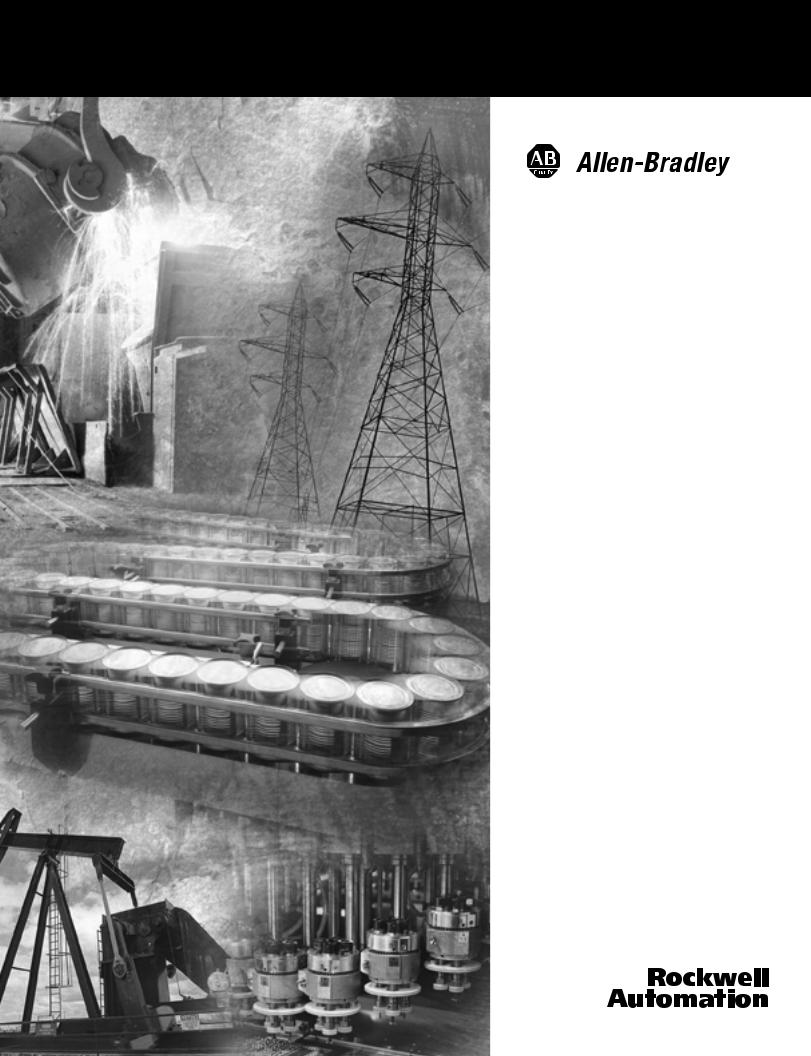
FLEX I/O Isolated
Analog Modules
1794-IF4I, -OF4I, IF2XOF2I, -IF4IXT, -IF4ICFXT, -OF4IXT, IF2XOF2IXT
User Manual

Important User Information |
Solid state equipment has operational characteristics differing from those of |
|||||||||||||
|
||||||||||||||
|
electromechanical equipment. Safety Guidelines for the Application, |
|||||||||||||
|
Installation and Maintenance of Solid State Controls (publication SGI-1.1 |
|||||||||||||
|
available from your local Rockwell Automation sales office or online at |
|||||||||||||
|
http://literature.rockwellautomation.com) describes some important |
|||||||||||||
|
differences between solid state equipment and hard-wired electromechanical |
|||||||||||||
|
devices. Because of this difference, and also because of the wide variety of |
|||||||||||||
|
uses for solid state equipment, all persons responsible for applying this |
|||||||||||||
|
equipment must satisfy themselves that each intended application of this |
|||||||||||||
|
equipment is acceptable. |
|||||||||||||
|
In no event will Rockwell Automation, Inc. be responsible or liable for |
|||||||||||||
|
indirect or consequential damages resulting from the use or application of |
|||||||||||||
|
this equipment. |
|
||||||||||||
|
The examples and diagrams in this manual are included solely for illustrative |
|||||||||||||
|
purposes. Because of the many variables and requirements associated with |
|||||||||||||
|
any particular installation, Rockwell Automation, Inc. cannot assume |
|||||||||||||
|
responsibility or liability for actual use based on the examples and diagrams. |
|||||||||||||
|
No patent liability is assumed by Rockwell Automation, Inc. with respect to |
|||||||||||||
|
use of information, circuits, equipment, or software described in this manual. |
|||||||||||||
|
Reproduction of the contents of this manual, in whole or in part, without |
|||||||||||||
|
written permission of Rockwell Automation, Inc., is prohibited. |
|||||||||||||
|
Throughout this manual, when necessary, we use notes to make you aware |
|||||||||||||
|
of safety considerations.S |
|||||||||||||
|
|
|
|
|
|
|
|
|
|
|
|
|
||
|
|
|
|
|
|
|
|
|
|
|
|
|
|
|
|
|
WARNING |
|
|
|
Identifies information about practices or circumstances that can |
||||||||
|
|
|
|
|
|
|
|
|
|
|
|
|
|
|
|
|
|
|
|
|
|
|
|
|
|
|
|
|
cause an explosion in a hazardous environment, which may lead to |
|
|
|
|
|
|
|
|
|
|
|
|
|
|
personal injury or death, property damage, or economic loss. |
|
|
|
|
|
|
|
|
|
|
|
|
|
|
|
|
|
|
|
|
|
|
|
|
|
|
|
|
|
|
|
|
|
|
|
|
|
|
|
|
|
|
|
|
|
|
|
|
|
|
|
|
|
|
|
|
|
|
|
Identifies information that is critical for successful application and |
|
|
IMPORTANT |
|
|||||||||||
|
|
|
understanding of the product. |
|||||||||||
|
|
|
|
|
|
|
|
|
|
|
|
|
|
|
|
|
|
|
|
|
|
|
|
||||||
|
|
|
|
|
|
|
|
|
|
|
|
|
|
Identifies information about practices or circumstances that can |
|
|
ATTENTION |
|
|
||||||||||
|
|
|
|
|
|
|
|
|
|
|
|
|
|
lead to: personal injury or death, property damage, or economic |
|
|
|
|
|
|
|
|
|
|
|
|
|
|
|
|
|
|
|
|
|
|
|
|
|
|
|
|
|
loss. Attentions help you identify a hazard, avoid a hazard, and |
|
|
|
|
|
|
|
|
|
|
|
|
|
|
recognize the consequence. |
|
|
|
|
|
|
|
|
|
|
|
||||
|
|
|
|
|
|
|
|
|||||||
|
|
|
|
|
|
|
|
|
|
|
|
|
|
|
|
|
SHOCK HAZARD |
Labels may be on or inside the equipment, such as a drive or motor, |
|||||||||||
|
|
|
|
|
|
|
|
|
|
|
|
|
|
|
|
|
|
|
|
|
|
|
|
|
|
|
|
|
to alert people that dangerous voltage may be present. |
|
|
|
|
|
|
|||||||||
|
|
|
|
|
|
|
|
|||||||
|
|
|
|
|||||||||||
|
|
|
|
|
|
|
|
|
|
|
|
|
|
|
|
|
BURN HAZARD |
Labels may be on or inside the equipment, such as a drive or motor, |
|||||||||||
|
|
|
|
|
|
|
|
|
|
|
|
|
|
|
|
|
|
|
|
|
|
|
|
|
|
|
|
|
|
|
|
|
|
|
|
|
|
|
|
|
|
|
|
to alert people that surfaces may reach dangerous temperatures. |
|
|
|
|
|
|
|
|
|
|
|
|
|
|
|
|
|
|
|
|
|
|
|
|
|
|
|
|
|
|
Rockwell Automation, Allen-Bradley, FLEX, RSNetWorx, RSLogix5000, and TechConnect are trademarks of Rockwell Automation, Inc.
Trademarks not belonging to Rockwell Automation are property of their respective companies.

Preface
Purpose of this Manual
Audience
Vocabulary
Using this Manual
This manual shows you how to use your FLEX I/O Isolated Analog modules with Allen-Bradley programmable controllers. The manual helps you install, program and troubleshoot your modules.
Except where noted, information that applies to 1794-IF4I, 1794-OF4I, and IF2XOF2I also applies to 1794-IF4IXT, 1794-IF4ICFXT, 1794-OF4IXT, and IF2XOF2IXT.
You must be able to program and operate an Allen-Bradley programmable controller to make efficient use of your FLEX I/O modules. In particular, you must know how to program block transfers.
We assume that you know how to do this in this manual. If you do not, refer to the appropriate programming and operations manual before you attempt to program your modules.
In this manual, we refer to:
•the isolated analog input or isolated analog output module as the “input module” or ‘‘output module”
•the Programmable Controller as the “controller”
Manual Organization
This manual is divided into five chapters. The following chart lists
each chapter with its corresponding title and a brief overview of the
topics covered in that chapter.
Section |
Title |
Contents |
|
|
|
Chapter 1 |
Overview of FLEX I/O and |
Describes FLEX I/O Isolated |
|
your Analog Modules |
Analog modules, features, |
|
|
and how they function |
|
|
|
Chapter 2 |
How to Install Your Analog |
How to install and wire the |
|
Module |
modules |
|
|
|
Chapter 3 |
Module Programming |
Explains block transfer |
|
|
programming, sample |
|
|
programs |
|
|
|
Publication 1794-6.5.8 - January 2010

Preface 4
Section |
Title |
Contents |
|
|
|
Chapter 4 |
Writing Configuration to and |
Explains how to configure |
|
Reading Status from Your |
your modules and read |
|
Module with a Remote I/O |
status information from your |
|
Adapter |
modules when using a |
|
|
remote I/O adapter |
|
|
|
Chapter 5 |
Communication and I/O |
Explains how you |
|
Image Table Mapping with |
communicate with your |
|
the DeviceNet/ControlNet |
modules, and how the I/O |
|
Adapter |
image is mapped when |
|
|
using a DeviceNet adapter |
|
|
|
Chapter 6 |
Input, Output, Status and |
Explains how you |
|
Configuration Files for |
communicate with your |
|
Analog Modules when used |
modules over ControlNet. |
|
with ControlNet |
|
|
|
|
Chapter 7 |
Calibrating Your Module |
Explains how to calibrate |
|
|
your module. |
|
|
|
Appendix A |
Specifications |
Specifications for the |
|
|
isolated analog modules |
|
|
|
Appendix B |
Class I, Division 2, Group A, |
Hazardous location approval |
|
B, C, D Hazardous Locations |
|
|
Statement |
|
|
|
|
Common Techniques Used in this Manual
For Additional Information
The following conventions are used throughout this manual:
•Bulleted lists such as this one provide information, not procedural steps.
•Numbered lists provide sequential steps or hierarchical information.
For additional information on FLEX I/O systems and modules, refer to the following documents:
Catalog Numbers |
Voltage |
Description |
Publications |
|
|
|
|
|
|
|
|
|
Installation |
User Manual |
|
|
|
Instructions |
|
|
|
|
|
|
1794 |
|
1794 FLEX I/O Product Data |
1794-2.1 |
|
|
|
|
|
|
1794-ACN |
24V dc |
ControlNet Adapter |
1794-5.8 |
|
|
|
|
|
|
1794-ACNR |
24V dc |
Redundant Media ControlNet Adapter |
1794-5.18 |
|
|
|
|
|
|
1794-ADN |
24V dc |
DeviceNet Adapter |
1794-5.14 |
1794-6.5.5 |
|
|
|
|
|
1794-ASB/C |
24V dc |
Remote I/O Adapter |
1794-5.46 |
1794-6.5.9 |
|
|
|
|
|
Publication 1794-6.5.8 - January 2010

Preface |
5 |
|
|
Catalog Numbers |
Voltage |
Description |
Publications |
|
|
|
|
|
|
|
|
|
Installation |
User Manual |
|
|
|
Instructions |
|
|
|
|
|
|
1794-ASB2 |
24V dc |
2-Slot Remote I/O Adapter |
1794-5.44 |
1794-6.5.3 |
|
|
|
|
|
1794-TB2 |
|
2-wire Terminal Base |
1794-5.2 |
|
1794-TB3 |
|
3-wire Terminal Base |
|
|
|
|
|
|
|
1794-TBN |
|
Terminal Base Unit |
1794-5.16 |
|
|
|
|
|
|
1794-TBNF |
|
Fused Terminal Base Unit |
1794-5.17 |
|
|
|
|
|
|
1794-TB3T |
|
Temperature Terminal Base Unit |
1794-5.41 |
|
|
|
|
|
|
1794-TB3S |
|
Spring Clamp Terminal Base Unit |
1794-5.42 |
|
|
|
|
|
|
1794-TB3TS |
|
Spring Clamp Temperature Terminal Base |
1794-5.43 |
|
|
|
Unit |
|
|
|
|
|
|
|
1794-IB16 |
24V dc |
16 Sink Input Module |
1794-5.4 |
|
|
|
|
|
|
1794-OB16 |
24V dc |
16 Source Output Module |
1794-5.3 |
|
|
|
|
|
|
1794-IV16 |
24V dc |
16 Source Input Module |
1794-5.28 |
|
|
|
|
|
|
1794-OV16 |
24V dc |
16 Sink Output Module |
1794-5.29 |
|
|
|
|
|
|
1794-OB8EP |
24V dc |
8 Electronically Fused Output Module |
1794-5.20 |
|
|
|
|
|
|
1794-OW8 |
24V dc |
8 Output Relay Module |
1794-5.19 |
|
|
|
|
|
|
1794-IB10XOB6 |
24V dc |
10 Input/6 Output Module |
1794-5.24 |
|
|
|
|
|
|
1794-IE8 |
24V dc |
Selectable Analog 8 Input Module |
1794-5.6 |
|
|
|
|
|
|
1794-OE4 |
24V dc |
Selectable Analog 4 Output Module |
1794-5.5 |
1794-6.5.2 |
|
|
|
|
|
1794-IE4XOE2 |
24V dc |
4 Input/2 Output Analog Module |
1794-5.15 |
|
|
|
|
|
|
1794-IR8 |
24V dc |
8 RTD Input Analog Module |
1794-5.22 |
1794-6.5.4 |
|
|
|
|
|
1794-IT8 |
24V dc |
8 Thermocouple Input Module |
1794-5.21 |
1794-6.5.7 |
|
|
|
|
|
1794-IB8S |
24V dc |
Sensor Input Module |
1794-5.7 |
|
|
|
|
|
|
1794-IA8 |
120V ac |
8 Input Module |
1794-5.9 |
|
|
|
|
|
|
1794-OA8 |
120V ac |
Output Module |
1794-5.10 |
|
|
|
|
|
|
1794-CE1, -CE3 |
|
Extender Cables |
1794-5.12 |
|
|
|
|
|
|
1794-NM1 |
|
Mounting Kit |
1794-5.13 |
|
|
|
|
|
|
1794-PS1 |
24V dc |
Power Supply |
1794-5.35 |
|
|
|
|
|
|
1794-PS13 |
24V dc |
Power Supply |
1794-5.69 |
|
|
|
|
|
|
Summary
This preface gave you information on how to use this manual efficiently. The next chapter introduces you to the remote I/O adapter module.
Publication 1794-6.5.8 - January 2010

Preface 6
Publication 1794-6.5.8 - January 2010

Table of Contents
Important User Information . . . . . . . . . . . . . . . . . . . . . . . . . . 2 Preface Using this Manual . . . . . . . . . . . . . . . . . . . . . . . . . . . . . . 3 Purpose of this Manual . . . . . . . . . . . . . . . . . . . . . . . . . . . . . 3 Audience . . . . . . . . . . . . . . . . . . . . . . . . . . . . . . . . . . . . . . . 3 Vocabulary . . . . . . . . . . . . . . . . . . . . . . . . . . . . . . . . . . . . . . 3 Manual Organization . . . . . . . . . . . . . . . . . . . . . . . . . . . . . . . 3 Common Techniques Used in this Manual . . . . . . . . . . . . . . . 4 For Additional Information . . . . . . . . . . . . . . . . . . . . . . . . . . 4 Summary . . . . . . . . . . . . . . . . . . . . . . . . . . . . . . . . . . . . . . . 5
Table of Contents
Overview of FLEX I/O and your Analog Modules
How to Install Your Analog Module
Module Programming
Chapter
Chapter Objectives . . . . . . . . . . . . . . . . . . . . . . . . . . . . . . . 11 The FLEX I/O System . . . . . . . . . . . . . . . . . . . . . . . . . . . . . 11 Types of FLEX I/O Modules . . . . . . . . . . . . . . . . . . . . . . . . 12 How FLEX I/O Analog Modules Communicate with Programmable Controllers . . . . . . . . . . . . . . . . . . . . . . . . . . 13 Features of Your Analog Modules . . . . . . . . . . . . . . . . . . . . 14 Summary . . . . . . . . . . . . . . . . . . . . . . . . . . . . . . . . . . . . . . 14
Chapter
Chapter Objectives . . . . . . . . . . . . . . . . . . . . . . . . . . . . . . . 15 Before You Install Your Analog Module. . . . . . . . . . . . . . . . 15 Compliance to European Union Directives . . . . . . . . . . . . . . 15 EMC Directive . . . . . . . . . . . . . . . . . . . . . . . . . . . . . . . . 15 Low Voltage Directive (to be confirmed). . . . . . . . . . . . . 16 Power Requirements . . . . . . . . . . . . . . . . . . . . . . . . . . . . . . 16 Installing the Module. . . . . . . . . . . . . . . . . . . . . . . . . . . . . . 18 Mounting the Terminal Base Unit on a DIN Rail . . . . . . . 18 Panel/Wall Mounting . . . . . . . . . . . . . . . . . . . . . . . . . . . 20 Mounting the Analog Module on the Terminal Base Unit. 22 Connecting Wiring for the Analog Modules . . . . . . . . . . . . . 23 Connecting Wiring using a 1794-TB3, -TB3T, -TB3S or -TB3TS Terminal Base Unit . . . . . . . . . . . . . . . . . . . . . . . . . . . . 24
Wiring to a 1794-TBN or 1794-TBNF Terminal Base Unit . 26
Module Indicators . . . . . . . . . . . . . . . . . . . . . . . . . . . . . . . . 30 Chapter Summary . . . . . . . . . . . . . . . . . . . . . . . . . . . . . . . . 30
Chapter
Chapter Objectives . . . . . . . . . . . . . . . . . . . . . . . . . . . . . . . 31 Block Transfer Programming . . . . . . . . . . . . . . . . . . . . . . . . 31 Configuration Rungs . . . . . . . . . . . . . . . . . . . . . . . . . . . . . . 32 Example Configuration Rungs. . . . . . . . . . . . . . . . . . . . . 32 Sample Programs for FLEX I/O Analog Modules. . . . . . . . . . 33 PLC-3 Programming . . . . . . . . . . . . . . . . . . . . . . . . . . . . 33 PLC-5 Programming . . . . . . . . . . . . . . . . . . . . . . . . . . . . 35 PLC-2 Programming . . . . . . . . . . . . . . . . . . . . . . . . . . . . 38 SLC-5 Programming. . . . . . . . . . . . . . . . . . . . . . . . . . . . . . . 38
Publication 1794-6.5.8 - January 2010

Table of Contents |
8 |
|
|
Writing Configuration to and Reading Status from Your Module with a Remote I/O Adapter
Communication and I/O Image Table Mapping with the DeviceNet/ControlNet Adapter
Input, Output, Status and Configuration Files for Analog Modules when used with ControlNet
Chapter Summary . . . . . . . . . . . . . . . . . . . . . . . . . . . . . . . . 51
Chapter
Chapter Objectives . . . . . . . . . . . . . . . . . . . . . . . . . . . . . . . 53 Configuring Your Analog Module . . . . . . . . . . . . . . . . . . . . 53 Range Selection . . . . . . . . . . . . . . . . . . . . . . . . . . . . . . . . . 54 Safe State Selection . . . . . . . . . . . . . . . . . . . . . . . . . . . . . . . 54 Data Format . . . . . . . . . . . . . . . . . . . . . . . . . . . . . . . . . . . . 54 Real Time Sampling . . . . . . . . . . . . . . . . . . . . . . . . . . . . . . 55 Input Filtering. . . . . . . . . . . . . . . . . . . . . . . . . . . . . . . . . . . 56 Reading Data From Your Module. . . . . . . . . . . . . . . . . . . . . 57 Mapping Data for the Analog Modules. . . . . . . . . . . . . . . . . 57
8 Input Analog Module (Cat. No. 1794-IF4I) . . . . . . . . . . 58 4 Isolated Output Analog Module (Cat. No. 1794-OF4I) . . 64 2 Input/2 Output Analog Combo Module (Cat. No.
1794-IF2XOF2I) . . . . . . . . . . . . . . . . . . . . . . . . . . . . . . . 69 Chapter Summary . . . . . . . . . . . . . . . . . . . . . . . . . . . . . . . . 76
Chapter
Chapter Objectives . . . . . . . . . . . . . . . . . . . . . . . . . . . . . . . 77 About RSNetWorx and RSLogix . . . . . . . . . . . . . . . . . . . . . . 77 Polled I/O Structure . . . . . . . . . . . . . . . . . . . . . . . . . . . . . . 77 Adapter Input Status Word . . . . . . . . . . . . . . . . . . . . . . . 78 Mapping Data into the Image Table . . . . . . . . . . . . . . . . . . . 79
4 Input Isolated Analog Module (Cat. No. 1794-IF4I) Image Table Mapping . . . . . . . . . . . . . . . . . . . . . . . . . . . . . . . 79 4 Output Isolated Analog Module (Cat. No. 1794-OF4I) Image Table Mapping . . . . . . . . . . . . . . . . . . . . . . . . . . . . . . . 86 Isolated Analog Combo Module (Cat. No. 1794-IF2XOF2I Series B) Image Table Mapping . . . . . . . . . . . . . . . . . . . 91
Defaults . . . . . . . . . . . . . . . . . . . . . . . . . . . . . . . . . . . . . . . 97
Chapter
Chapter Objectives . . . . . . . . . . . . . . . . . . . . . . . . . . . . . . . 99 About the ControlNet Adapter . . . . . . . . . . . . . . . . . . . . . . . 99 Commun ication Over the FLEX I/O Backplane . . . . . . . . . . 99 Polled I/O Structure . . . . . . . . . . . . . . . . . . . . . . . . . . . . . 100 Adapter Input Status Word . . . . . . . . . . . . . . . . . . . . . . 101 Safe State Data . . . . . . . . . . . . . . . . . . . . . . . . . . . . . . . . . 102 Communication Fault Behavior . . . . . . . . . . . . . . . . . . . . . 102 Idle State Behavior . . . . . . . . . . . . . . . . . . . . . . . . . . . . . . 102 Input Data Behavior Upon Module Removal . . . . . . . . . . . 103
4 Input Isolated Analog Module (Cat. No. 1794-IF4I) Image Table Mapping . . . . . . . . . . . . . . . . . . . . . . . . . . . . . . 103
Publication 1794-6.5.8 - January 2010

|
Table of Contents |
9 |
|
4 Output Isolated Analog Module (Cat. No. 1794-OF4I) Image |
|
|
Table Mapping . . . . . . . . . . . . . . . . . . . . . . . . . . . . . . |
108 |
|
Isolated Analog Combo Module (Cat. No. 1794-IF2XOF2I) |
|
|
Image Table Mapping . . . . . . . . . . . . . . . . . . . . . . . . . |
113 |
|
Chapter |
|
Calibrating Your Module |
Chapter Objective . . . . . . . . . . . . . . . . . . . . . . . . . . . . . . . |
119 |
|
When and How to Calibrate Your Isolated Analog Module . 119 |
|
|
Tools and Equipment . . . . . . . . . . . . . . . . . . . . . . . . . . . . |
120 |
|
Calibrating Your Isolated Analog Input Module . . . . . . . . . |
121 |
|
Bits Used During Calibration . . . . . . . . . . . . . . . . . . . . |
121 |
|
Offset Calibration for Inputs . . . . . . . . . . . . . . . . . . . . . |
122 |
|
Setting the Input Gain . . . . . . . . . . . . . . . . . . . . . . . . . |
124 |
|
Calibrating Your Isolated Analog Output Module . . . . . . . . |
125 |
|
Bits Used During Calibration . . . . . . . . . . . . . . . . . . . . |
125 |
|
Calibrating Voltage Outputs . . . . . . . . . . . . . . . . . . . . . |
126 |
|
Offset Calibration for Voltage Outputs 126 |
|
|
Gain Calibration for Outputs 127 |
|
|
Calibrating Current Outputs . . . . . . . . . . . . . . . . . . . . . |
128 |
|
Gain Calibration for Current Outputs 128 |
|
|
Offset Calibration for Current Outputs 128 |
|
|
Final Gain Calibration for Current Inputs 130 |
|
|
Scaling Inputs . . . . . . . . . . . . . . . . . . . . . . . . . . . . . . . |
131 |
|
Scaling Outputs . . . . . . . . . . . . . . . . . . . . . . . . . . . . . . |
132 |
|
Chapter Summary . . . . . . . . . . . . . . . . . . . . . . . . . . . . . . . |
132 |
|
Appendix |
|
Specifications |
Filter Response for 150Hz, 300Hz and 600Hz Conversion 134 |
|
|
Appendix |
|
Class I, Division 2, Group A, B, C, D |
|
|
Hazardous Locations Statement |
|
|
Index |
|
|
Publication 1794-6.5.8 - January 2010

Table of Contents |
10 |
|
|
Publication 1794-6.5.8 - January 2010
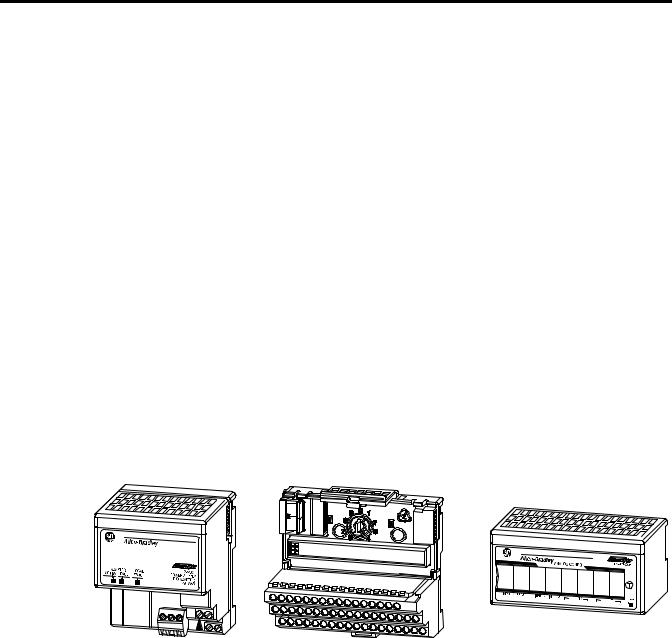
Chapter 1
Overview of FLEX I/O and your Analog Modules
Chapter Objectives
In this chapter, we tell you about:
•what the FLEX I/O system is and what it contains
•types of FLEX I/O analog modules
•how FLEX I/O analog modules communicate with programmable controllers
•the features of your analog modules
The FLEX I/O System
FLEX I/O is a small, modular I/O system for distributed applications that performs all of the functions of rack-based I/O. The FLEX I/O system contains the following components shown in Figure 1.1:
Figure 1.1
Adapter |
Terminal Base |
I/O Module |
5
I V I V I V I
 V I
V I 

 V
V 
 I
I 

 V
V
20125
•adapter/power supply – powers the internal logic for as many as eight I/O modules
•terminal base – contains a terminal strip to terminate wiring for twoor three-wire devices
•I/O module – contains the bus interface and circuitry needed to perform specific functions related to your application
Publication 1794-6.5.8 - January 2010

12 Overview of FLEX I/O and your Analog Modules
Types of FLEX I/O Modules |
We describe the following FLEX I/O Analog modules in this user man- |
||||
|
|
ual: |
|
|
|
|
|
|
|
|
|
|
Catalog Number |
Voltage |
Inputs |
Outputs |
Description |
|
|
|
|
|
|
|
1794-IF4I |
24V dc |
4 |
– |
analog – 4 input, isolated |
|
|
|
|
|
|
|
1794-OF4I |
24V dc |
– |
4 |
analog – 4 output, isolated |
|
|
|
|
|
|
|
1794-IF2XOF2I |
24V dc |
2 |
2 |
analog – 2 input, isolated and 2 output, isolated |
|
|
|
|
|
|
FLEX I/O analog input, output and combination modules are block transfer modules that interface analog signals with any Allen-Bradley programmable controllers that have block transfer capability. Block transfer programming moves input from the module’s memory to a designated area in the processor data table, and output data words from a designated area in the processor data table to the module’s memory. Block transfer programming also moves configuration words from the processor data table to module memory.
The analog modules have selectable ranges as shown in the table below:
Input Values |
Data Format |
Underrange/Overrange |
|
|
|
4–20mA |
signed 2’s complement |
4% Underrange, 4% Overrange |
|
|
|
±10V |
signed 2’s complement |
2% Underrange, 2% Overrange |
|
|
|
±5V |
signed 2’s complement |
4% Underrange, 4% Overrange |
|
|
|
0–20mA |
signed 2’s complement % |
0% Underrange, 4% Overrange |
|
|
|
4-20mA |
signed 2’s complement % |
4% Underrange, 4% Overrange |
|
|
|
0–10V |
signed 2’s complement % |
0% Underrange, 2% Overrange |
|
|
|
±10V |
signed 2’s complement % |
2% Underrange, 2% Overrange |
|
|
|
0–20mA |
binary |
0% Underrange, 4% Overrange |
|
|
|
4–20mA |
binary |
4% Underrange, 4% Overrange |
|
|
|
0–10V |
binary |
0% Underrange, 2% Overrange |
|
|
|
0–5V |
binary |
0% Underrange, 4% Overrange |
|
|
|
±20mA |
offset binary, 8000H = 0mA |
4% Underrange, 4% Overrange |
|
|
|
4–20mA |
offset binary, 8000H = 4mA |
4% Underrange, 4% Overrange |
|
|
|
±10V |
offset binary, 8000H = 0V |
2% Underrange, 2% Overrange |
|
|
|
±5V |
offset binary, 8000H = 0V |
4% Underrange, 4% Overrange |
|
|
|
Publication 1794-6.5.8 - January 2010
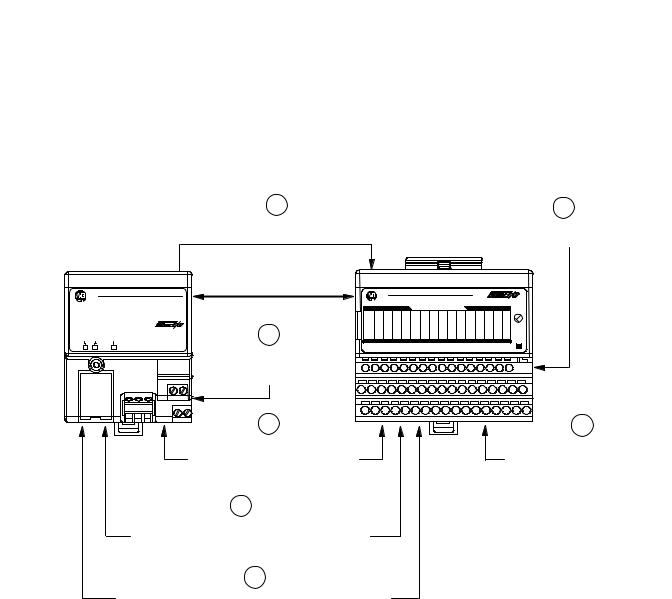
Overview of FLEX I/O and your Analog Modules |
13 |
|
|
How FLEX I/O Analog Modules Communicate with Programmable Controllers
The adapter/power supply transfers data to the module (block transfer write) and from the module (block transfer read) using BTW and BTR instructions in your ladder diagram program. These instructions let the adapter obtain input values and status from the module, and let you send output values and establish the module’s mode of operation. Figure 1.2 describes the communication process.
Figure 1.2
An Example of Communication Between an Adapter and an Analog Input Module
Allen-Bradley
ADAPTER |
LOCAL |
|
24VDC |
|||||||
|
POWER SUPPLY |
|||||||||
ACTIVE |
|
|
FAULT |
FAULT |
|
|||||
|
|
|
RIO ADAPTER |
|||||||
|
|
|
|
|
|
|
|
|
|
|
|
|
|
|
|
|
|
|
|
|
1794-ASB |
|
|
|
|
|
|
|
|
|
|
|
1 |
2 |
The adapter transfers your configuration data to the module using a BTW.
Flexbus
External devices transmit analog signals to the module.
Allen-Bradley |
1794±IE8 |
ANALOG INPUT
2
4 |
|
|
|
|
|
|
|
Your ladder program instructs the |
INPUT 0 INPUT 1 |
INPUT 2 INPUT 3 |
INPUT 4 |
INPUT 5 |
INPUT 6 |
INPUT 7 |
|
I V |
I V |
I V I V |
I V |
I V |
I V |
I V |
|
|
|
|
|
|
|
|
|
adapter to perform a BTR of the values |
|
|
|
|
|
|
|
and stores them in a data table. |
|
|
|
|
|
|
|
5 |
|
|
|
|
|
|
3 |
The adapter and module determine
that the transfer was made without error and input values are within specified range.
6
Your ladder program can use and/or move the data (if valid) before it is written over by the transfer of new data in a subsequent transfer.
7
Your ladder program performs BTWs to the module when you power it up, and any time you wish to reconfigure the module.
The module converts analog signals into integer format and stores these values until the adapter requests their transfer.
Publication 1794-6.5.8 - January 2010

14 Overview of FLEX I/O and your Analog Modules
Features of Your Analog
Modules
Each module has a unique label identifying its keyswitch position, wiring and module type. A removable label provides space for writing individual designations per your application.
1794-IF4I
Input Designators
1794-OF4I
Output Designators
1794-IF2XOF2I
Input and Output Designators
Module Type
Removable
Label
Keyswitch
Position
Indicator (#3)
Green Power/Status
Indicator
Module Type
Removable
Label
Keyswitch
Position
Indicator (#4)
Green Power/Status
Indicator
Module Type
Removable
Label
Keyswitch
Position
Indicator (#5)
Green Power/Status
Indicator
Summary
In this chapter you learned about the FLEX I/O system and the types of analog modules and how they communicate with programmable controllers.
Publication 1794-6.5.8 - January 2010

Chapter 2
How to Install Your Analog Module
Chapter Objectives
In this chapter, we tell you about:
•how to install your module
•how to set the module keyswitch
•how to wire the terminal base
•the indicators
Before You Install Your
Analog Module
Before installing your analog module in the I/O chassis:
You need to: |
As described under: |
|
|
Calculate the power requirements of all |
Power Requirements, page 2-16 |
modules in each chassis. |
|
|
|
Position the keyswitch on the terminal base |
Mounting the Analog Module on the |
|
Terminal Base Unit, page 2-22 |
|
|
Compliance to European Union Directives
If this product has the CE mark it is approved for installation within the European Union and EEA regions. It has been designed and tested to meet the following directives.
EMC Directive
This product is tested to meet Council Directive 2004/10/EC Electromagnetic Compatibility (EMC) and the following standards, in whole or in part, documented in a technical construction file:
•European Union 2004/108/EC EMC Directive, compliant with: EN 61326-1; Meas./Control/Lab., Industrial Requirements
EN 61000-6-2; Industrial Immunity EN 61000-6-4; Industrial Emissions
EN 61131-2; Programmable Controllers (Clause 8, Zone A & B)
•European Union 2006/95/EC LVD, compliant with: EN 61131-2; Programmable Controllers (Clause 11)
This product is intended for use in an industrial environment.
Publication 1794-6.5.8 - January 2010

16 How to Install Your Analog Module
Low Voltage Directive
Power Requirements
This product is tested to meet Council Directive 2006/95/EC Low Voltage, by applying the safety requirements of EN 61131–2 Programmable Controllers, Part 2 – Equipment Requirements and Tests.
For specific information required by EN 61131-2, see the appropriate sections in this publication, as well as the following Allen-Bradley publications:
•Industrial Automation Wiring and Grounding Guidelines For Noise Immunity, publication 1770-4.1
•Guidelines for Handling Lithium Batteries, publication AG-5.4
•Automation Systems Catalog, publication B111
Open style devices must be provided with environmental and safety protection by proper mounting in enclosures designed for specific application conditions. See NEMA Standards publication 250 and IEC publication 529, as applicable, for explanations of the degrees of protection provided by different types of enclosure.
The wiring of the terminal base unit is determined by the current draw through the terminal base. Make certain that the current draw does not exceed 10A.
ATTENTION |
Total current draw through the terminal base unit is |
|||
limited to 10A. Separate power connections may be |
||||
|
|
|
||
|
|
|
||
|
|
|
necessary. |
|
|
|
|
|
|
|
|
|
|
|
|
|
|
|
|
Publication 1794-6.5.8 - January 2010

|
|
How to Install Your Analog Module |
17 |
|
|
|
|
Methods of wiring the terminal base units are shown in the illustration below.
ATTENTION |
Do not daisy chain power or ground from an analog |
|||
terminal base unit to any ac or dc discrete module |
||||
|
|
|
||
|
|
|
||
|
|
|
terminal base unit. |
|
|
|
|
|
|
|
|
|
|
|
|
|
|
|
|
Daisy-chaining
24V dc |
Note: All modules must be analog modules for this configuration. |
Wiring when total current draw is less than 10A
Individual
24V dc
24V dc or
120V ac
24V dc
Note: Use this configuration if using any ªnoisyº dc discrete I/O modules in your system.
Analog module wiring separate from discrete wiring.
Wiring when total current draw is greater than 10A
Combination
24V dc
24V dc
Note: All modules powered by the same power supply must be analog modules for this configuration.
Total current draw through any base unit must not be greater than 10A
Publication 1794-6.5.8 - January 2010
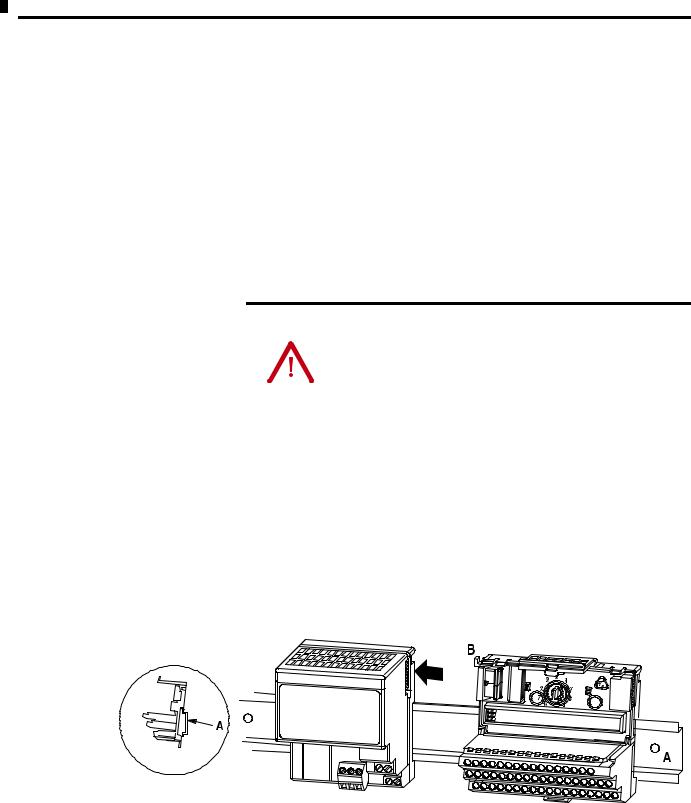
18 How to Install Your Analog Module
Installing the Module
Installation of the analog module consists of:
•mounting the terminal base unit
•installing the analog module into the terminal base unit
•installing the connecting wiring to the terminal base unit
If you are installing your module into a terminal base unit that is already installed, proceed to Mounting the Analog Module on the Terminal Base Unit on page 2-22.
Mounting the Terminal Base Unit on a DIN Rail
ATTENTION |
Do not remove or replace a terminal base unit when |
|||
power is applied. Interruption of the flexbus can |
||||
|
|
|
||
|
|
|
||
|
|
|
result in unintended operation or machine motion. |
|
|
|
|
|
|
|
|
|
|
|
|
|
|
|
|
1.Remove the cover plug (if used) in the male connector of the unit to which you are connecting this terminal base unit.
2.Check to make sure that the 16 pins in the male connector on the adjacent device are straight and in line so that the mating female connector on this terminal base unit will mate correctly.
3.Position the terminal base on the 35 x 7.5mm DIN rail A (A-B pt. no. 199-DR1; 46277-3; EN 50022) at a slight angle with hook B on the left side of the terminal base hooked into the right side of the unit on the left. Proceed as follows:
Figure 2.1
Position terminal base at a slight angle and hooked over the top of the DIN rail.
Publication 1794-6.5.8 - January 2010
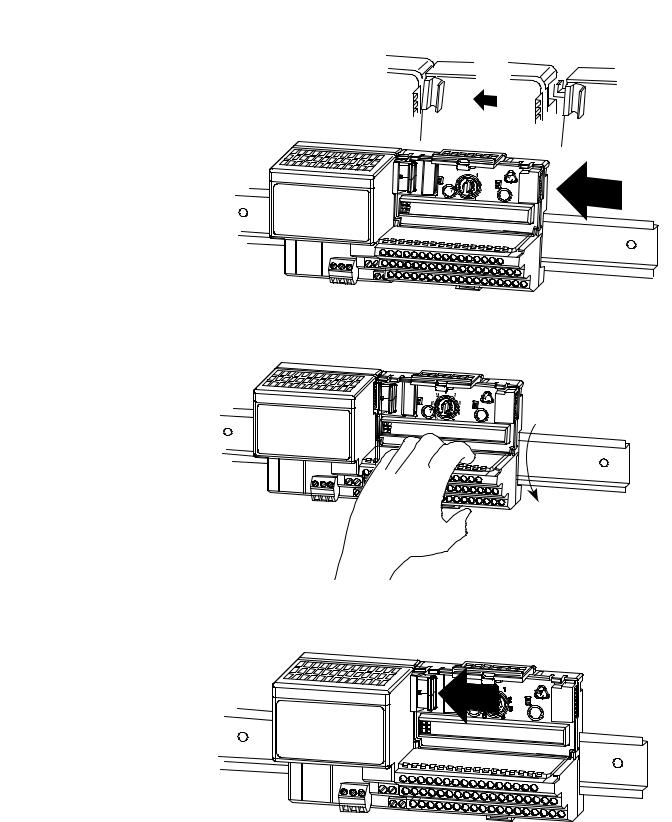
|
|
How to Install Your Analog Module |
19 |
|
|
|
|
Figure 2.2
Slide the terminal base unit over tight against the adapter.
Make sure the hook on the terminal base slides under the edge of the adapter and the flexbus connector is fully retracted.
Press down on the terminal base unit to lock the terminal base on the DIN rail. If the terminal base does not lock into place, use a screwdriver or similar device to open the locking tab, press down on the terminal base until flush with the DIN rail and release the locking tab to lock the base in place.
Gently push the flexbus connector into the side |
|
of the adapter to complete the backplane connection. |
30077-M |
4. Repeat steps 1 - 3 to install the next terminal base.
Publication 1794-6.5.8 - January 2010
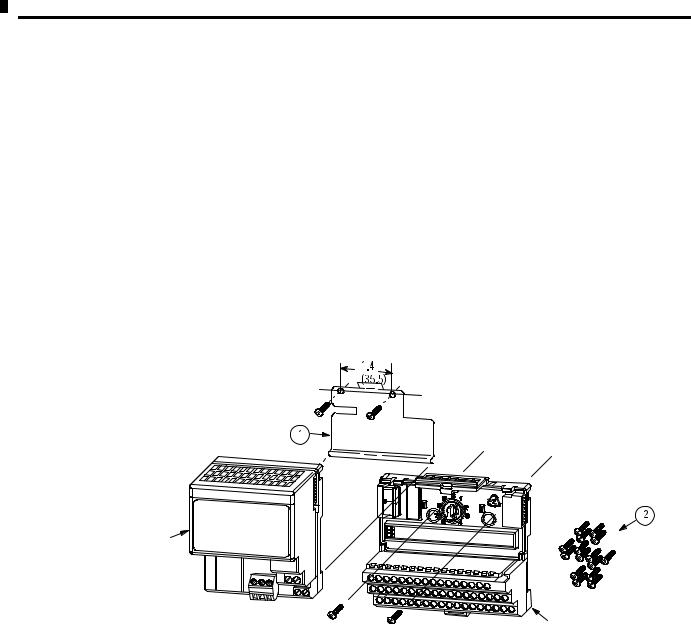
20 How to Install Your Analog Module
Panel/Wall Mounting
Installation on a wall or panel consists of:
•laying out the drilling points on the wall or panel
•drilling the pilot holes for the mounting screws
•mounting the adapter mounting plate
•installing the terminal base units and securing them to the wall or panel
If you are installing your module into a terminal base unit that is already installed, proceed to “Mounting the Analog Module on the Terminal Base” on .
Use the mounting kit Cat. No. 1794-NM1 for panel/wall mounting.
1794-NM1 Mounting Kit
Contents:
1 ± Mounting Plate for Adapter
2 ± 18 #6 self-tapping screws (2 for the adapter, and 2 each for up to 8 modules)
Adapter Module (not included)
Terminal Base Unit
(not included)
Publication 1794-6.5.8 - January 2010
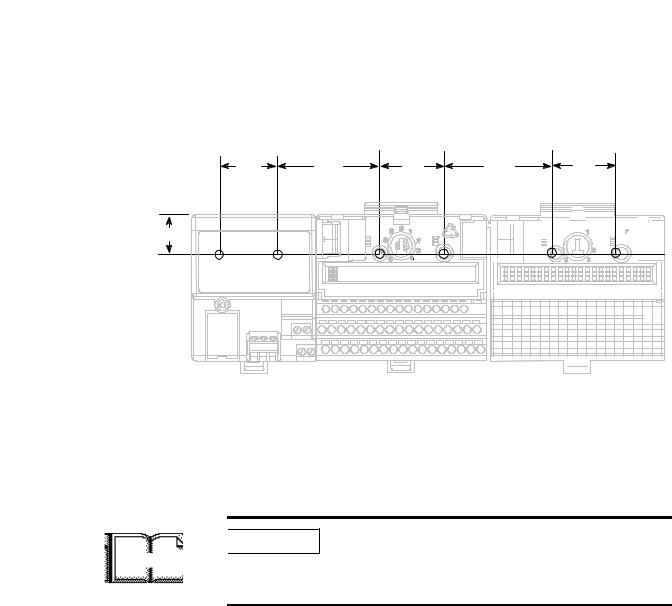
|
|
How to Install Your Analog Module |
21 |
|
|
|
|
Inches (Millimeters)
.83 (21)
More
To install the mounting plate on a wall or panel:
1.Lay out the required points on the wall/panel as shown in the drilling dimension drawing.
Figure 2.3 Drilling Dimensions for Panel/Wall Mounting of FLEX I/O
1.4 |
2.3 |
1.4 |
2.3 |
1.4 |
(35.5) |
(58.5) |
(35.5) |
(58.5) |
(35.5) |
2.Drill the necessary holes for the #6 self-tapping mounting screws.
3.Mount the mounting plate (1) for the adapter module using two #6 self-tapping screws (18 included for mounting up to 8 modules and the adapter).
|
Make certain that the mounting plate is properly |
|
IMPORTANT |
||
grounded to the panel. Refer to “Industrial |
||
|
||
|
||
|
Automation Wiring and Grounding Guidelines,” |
|
|
publication 1770-4.1. |
4.Hold the adapter (2) at a slight angle and engage the top of the mounting plate in the indention on the rear of the adapter module.
5.Press the adapter down flush with the panel until the locking lever locks.
6.Position the terminal base unit up against the adapter and push the female bus connector into the adapter.
7.Secure to the wall with two #6 self-tapping screws.
8.Repeat for each remaining terminal base unit.
The adapter is capable of addressing eight modules. Do not exceed a maximum of eight terminal base units in your system.
Publication 1794-6.5.8 - January 2010
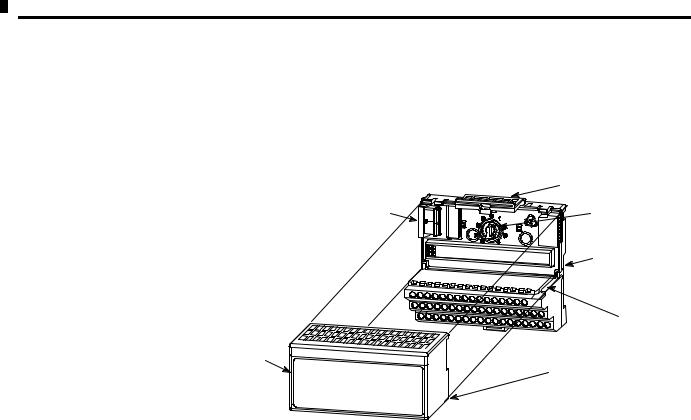
22 How to Install Your Analog Module
Mounting the Analog Module on the Terminal Base Unit
1.Rotate the keyswitch (1) on the terminal base unit (2) clockwise to the position required for the specific type of analog module.
Figure 2.4
|
7 |
3 |
1 |
|
2
6
4
5
|
|
Analog Module Catalog Number |
Keyswitch Position |
|
|
|
|
|
|
|
|
1794-IF4I, 1794-IF4IXT, 1794-IF4ICFXT |
3 |
|
|
|
|||
|
|
|
|
|
|
|
1794-OF4I, |
1794-OF4IXT |
4 |
|
|
|||
|
|
|
|
|
|
|
1794-IF2XOF2I, |
1794-IF2XOF2IXT |
5 |
|
|
|||
|
|
|
|
|
2.Make certain the flexbus connector (3) is pushed all the way to the left to connect with the neighboring terminal base/adapter.
You cannot install the module unless the connector is fully extended.
3.Make sure that the pins on the bottom of the module are straight so they will align properly with the connector in the terminal base unit.
4.Position the module (4) with its alignment bar (5) aligned with the groove (6) on the terminal base.
5.Press firmly and evenly to seat the module in the terminal base unit. The module is seated when the latching mechanism (7) is locked into the module.
Publication 1794-6.5.8 - January 2010
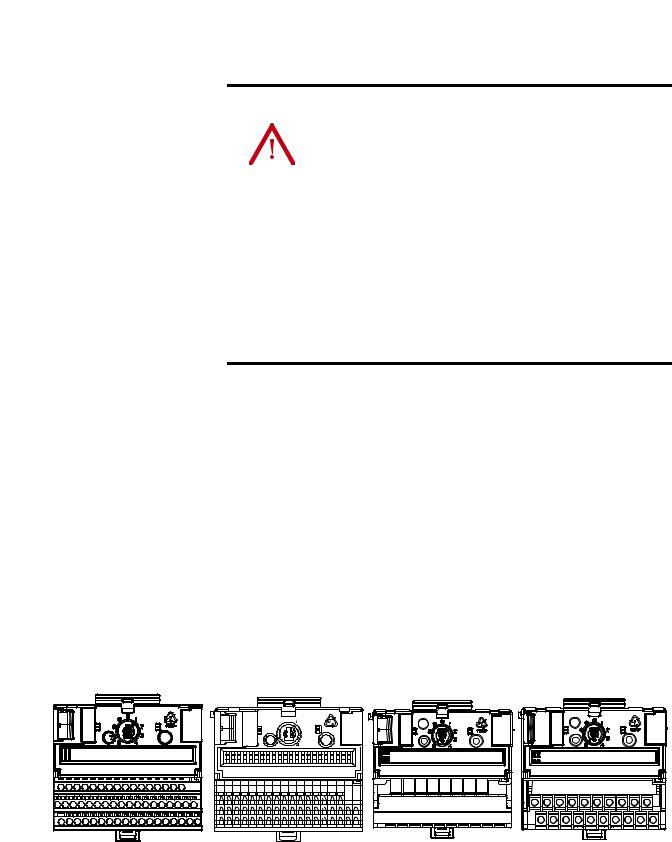
|
|
How to Install Your Analog Module |
23 |
|
|
|
|
6.Repeat the above steps to install the next module in its terminal base unit.
ATTENTION |
Remove field-side power before removing or |
|||
inserting the module. This module is designed so |
||||
|
|
|
||
|
|
|
||
|
|
|
you can remove and insert it under backplane |
|
|
|
|
power. When you remove or insert a module with |
|
|
|
|
field-side power applied, an electrical arc may occur. |
|
|
|
|
An electrical arc can cause personal injury or |
|
|
|
|
property damage by: |
|
•sending an erroneous signal to your system’s field devices causing unintended machine motion
•causing an explosion in a hazardous environment
Connecting Wiring for the Analog Modules
Repeated electrical arcing causes excessive wear to contacts on both the module and its mating connector. Worn contacts may create electrical resistance.
Wiring to the analog modules is made through the terminal base unit on which the module mounts.
Refer to the following table for recommended terminal base units that you can use for each module.
|
|
Module |
1794-TB3 |
|
1794-TBT |
1794-TB3S |
1794-TB3TS |
1794-TB3S |
1794-TBN, |
|
|
|
|
|
|
|
|
|
-TBNF |
|
|
|
|
|
|
|
|
|
|
|
|
1794-IF4I, 1794-IF4IXT, |
Yes |
|
Yes |
Yes |
Yes |
Yes |
Yes |
|
|
|
|||||||
|
|
1794-IF4ICFXT |
|
|
|
|
|
|
|
|
|
|
|
|
|
|
|
|
|
|
|
1794-OF4I, 1794-OF4IXT |
Yes |
|
Yes |
Yes |
Yes |
Yes |
Yes |
|
|
|
|||||||
|
|
|
|
|
|
|
|
|
|
|
|
1794-IF2XOF2I, |
Yes |
|
Yes |
Yes |
Yes |
Yes |
Yes |
|
|
|
|||||||
|
|
1794-IF2XOF2IXT |
|
|
|
|
|
|
|
|
|
|
|
|
|
|
|
|
|
|
|
|
|
Figure 2.5 |
|
|
|
|
|
1794-TB3, -TB3T |
1794-TB3S, -TB3TS |
1794-TBNF |
1794-TBN |
Publication 1794-6.5.8 - January 2010
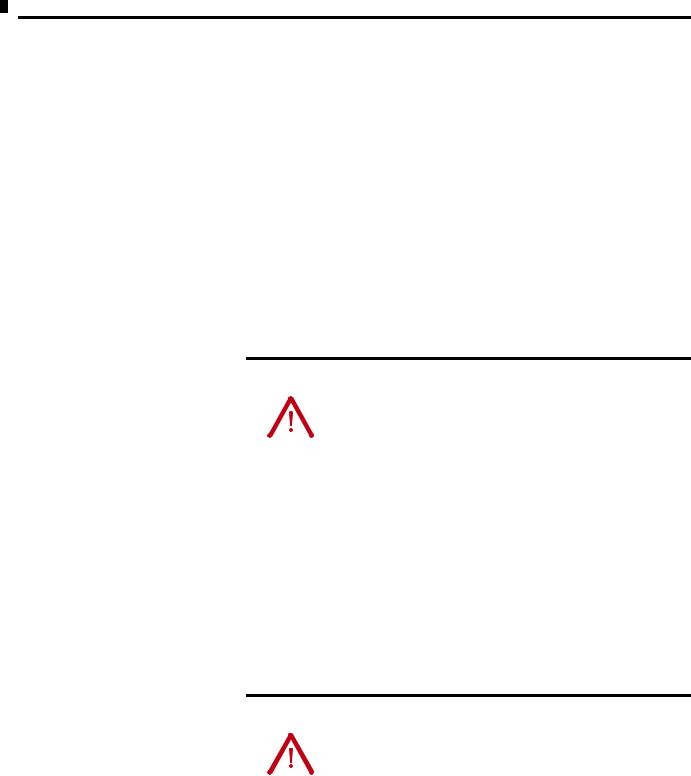
24 How to Install Your Analog Module
Connecting wiring for the individual analog modules is shown on:
|
|
Module |
|
Connecting Wiring |
|
|
|
|
|
|
|
1794-IF4I, 1794-IF4IXT, 1794-IF4ICFXT |
page 2-26 |
|
|
|
|||
|
|
|
|
|
|
|
1794-OF4I, |
1794-OF4IXT |
|
|
|
|
||
|
|
|
|
|
|
|
1794-IF2XOF2I, |
1794-IF2XOF2IXT |
page 2-27 |
|
|
|||
|
|
|
|
|
Connecting Wiring using a 1794-TB3, -TB3T, -TB3S or -TB3TS
Terminal Base Unit
1.Connect the individual signal wiring to numbered terminals on the 0–15 row (A) on the terminal base unit. (Use Belden 8761 cable for signal wiring.)
ATTENTION |
Connect only one current or one voltage signal per |
|||
channel. Do not connect both current and voltage on |
||||
|
|
|
||
|
|
|
||
|
|
|
one channel. |
|
|
|
|
|
|
|
|
|
|
|
|
|
|
|
|
2.Connect each channel signal return to: 1794-IF4I – the associated terminal on row A.
1794-OF4I – the corresponding terminal on the same row (A)
1794-IF4XOF2I – inputs – the associated terminal on row A; outputs – the corresponding terminal on the same row (A).
3.Refer to Table 2.1 or Table 2.2. Connect +24V dc to designated terminals on the 34-51 row (C), and 24V common todesignated terminals on the 16–33 row (B).
ATTENTION |
To reduce susceptibility to noise, power analog |
|||
modules and discrete modules from separate power |
||||
|
|
|
||
|
|
|
||
|
|
|
supplies. Do not exceed a length of 33 ft (10m) for |
|
|
|
|
dc power cabling. |
|
|
|
|
|
|
|
|
|
|
|
Publication 1794-6.5.8 - January 2010
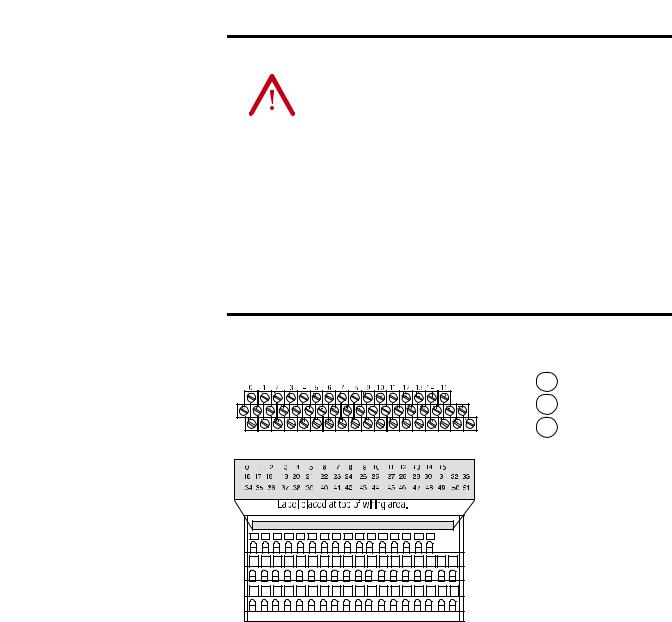
|
|
How to Install Your Analog Module |
25 |
|
|
|
|
ATTENTION |
Remove field-side power before removing or |
|||
inserting the module. This module is designed so |
||||
|
|
|
||
|
|
|
||
|
|
|
you can remove and insert it under backplane |
|
|
|
|
power. When you remove or insert a module with |
|
|
|
|
field-side power applied, an electrical arc may occur. |
|
|
|
|
An electrical arc can cause personal injury or |
|
|
|
|
property damage by: |
|
•sending an erroneous signal to your system’s field devices causing unintended machine motion
•causing an explosion in a hazardous environment
Repeated electrical arcing causes excessive wear to contacts on both the module and its mating connector. Worn contacts may create electrical resistance.
0 ±15 A
16±33 B
34±51 C
1794-TB3, -TB3T
Row A
Row B
Row C
Row A
Row B
Row C
1794-TB3S, -TB3TS
4.If daisy chaining the +24V dc power to the next base unit, connect a jumper from terminal 51 on this base unit to terminal 34 on the next base unit. Connect the 24V dc common/return from terminal 33 on this base unit to terminal 16 on the next base unit.
Publication 1794-6.5.8 - January 2010
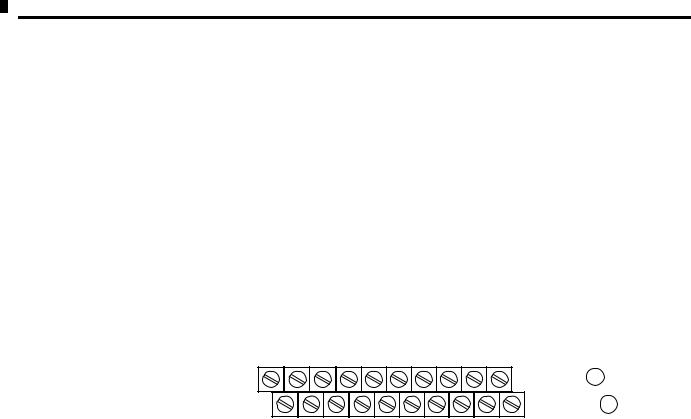
26 How to Install Your Analog Module
Wiring to a 1794-TBN or 1794-TBNF Terminal Base Unit
1.Connect individual input or output wiring to the even numbered terminals on row (B) as indicated in the table below.
2.Connect the associated return wiring to the corresponding odd numbered terminal on row (C) for each input or output as indicated in the table below.
3.Connect 24V dc to terminal 34 on row (C).
4.Connect 24V dc common to terminal 16 on row (B).
5.If continuing power to the next terminal base unit, connect a jumper from terminal 51 (24V dc) on this base unit to terminal 34 on the next base unit.
16 |
|
|
Even Numbered Terminals 0 thru 14 |
|
33 |
16, 0, 2, 4, 6, |
|
|||||
16 |
0 |
2 |
4 |
6 |
8 |
10 |
12 |
14 |
33 |
|
B |
|
|
|
|
|
|
|
|
|
|
|
|
8, 10, 12, 14, 33 |
|
|
|
|
|
|
|
|
|
|
|
|
|
|
34 |
|
1 |
3 |
5 |
7 |
9 |
11 |
13 |
15 |
51 |
34, 1, 3, 5, 7, |
C |
|
|
|
|
|
|
|
|
|
|
|
||
|
|
|
|
|
|
|
|
|
|
|
9, 11, 13, 15, 51 |
|
|
|
|
|
|
|
|
|
|
|
|
|
|
|
34 |
|
Odd Numbered Terminals 1 thru 15 |
|
|
51 |
|
|||||
1794-TBN, 1794-TBNF
If continuing common to the next terminal base unit, connect a jumper from terminal 33 (24V dc common) on this base unit to terminal 16 on the next base unit.
Table 2.1
Wiring connections for 1794-TB3, -TB3T, -TB3S, -TB3TS, -TBN and -TBNF Terminal Base
Units when using the 1794-IF4I or 1794-OF4I Isolated Analog Module
Channel |
Signal Type |
Label Markings |
1794-TB3, -TB3T1, -TB3S, -TB3TS(2) |
|
|
|
|
1794-TBN, 1794-TBNF |
|
|
|
|
|
|
|
|
|
Signal |
Signal Return |
|
|
|
Terminal |
|
|
|
|
|
|
0 |
Current |
I0 |
0 |
|
|
|
|
|
|
|
Current |
I0 Ret |
|
1 |
|
|
|
|
|
|
Voltage |
V0 |
2 |
|
|
|
|
|
|
|
Voltage |
V0 Ret |
|
3 |
|
|
|
|
|
1 |
Current |
I1 |
4 |
|
|
|
|
|
|
|
Current |
I1 Ret |
|
5 |
|
|
|
|
|
|
Voltage |
V1 |
6 |
|
|
|
|
|
|
|
Voltage |
V1 Ret |
|
7 |
|
|
|
|
|
Publication 1794-6.5.8 - January 2010

|
|
How to Install Your Analog Module |
27 |
|
|
|
|
Table 2.1
Wiring connections for 1794-TB3, -TB3T, -TB3S, -TB3TS, -TBN and -TBNF Terminal Base
Units when using the 1794-IF4I or 1794-OF4I Isolated Analog Module
Channel |
Signal Type |
Label Markings |
|
1794-TB3, -TB3T1, -TB3S, -TB3TS(2) |
|
|
|
|
|
1794-TBN, 1794-TBNF |
|
|
|
|
|
|
|
|
|
|
|
Signal |
Signal Return |
|
|
|
|
Terminal |
|
|
|
|
|
|
|
2 |
Current |
I2 |
|
8 |
|
|
|
|
|
|
|
|
Current |
I2 Ret |
|
|
9 |
|
|
|
|
|
|
|
Voltage |
V2 |
|
10 |
|
|
|
|
|
|
|
|
Voltage |
V2 Ret |
|
|
11 |
|
|
|
|
|
|
3 |
Current |
I3 |
|
12 |
|
|
|
|
|
|
|
|
Current |
I3 Ret |
|
|
13 |
|
|
|
|
|
|
|
Voltage |
V3 |
|
14 |
|
|
|
|
|
|
|
|
Voltage |
V3 Ret |
|
|
15 |
|
|
|
|
|
|
|
|
|
|
|
|
|
24V dc Common |
1794-TB3 – 16 through 33(1) |
|||
|
|
1794-TB3T, -TB3TS – 17, 18, 33 |
|||
|
|
1794-TBN, -TBNF – 16 and 33 |
|||
|
|
|
|
||
|
+24V dc power |
|
1794-TB3 – 34 thru 51 |
||
|
|
1794-TB3T, -TB3TS – 34, 35, 50, 51 |
|||
|
|
1794-TBN, -TBNF – 34 and 51 |
|||
|
|
|
|
|
|
(1)Terminals 16 thru 33 are internally connected in the terminal base unit.
(2)Terminal 39 through 46 are chassis ground. Terminals 36, 37, 38 and 47, 48, 49 are used or cold junction compensation.
Table 2.2
Wiring connections for the 1794-IF2XOF2I Isolated Analog Module when using 1794-TB3, -TB3T, -TB3S, -TB3TS, -TBN and -TBNF Terminal Base Units
Channel |
Signal Type |
Label Markings |
1794-TB3, -TB3T(2), -TB3S, |
|
|
|
|
-TB3TS(2) -TBN, -TBNF |
|
|
|
|
Signal |
Signal Return |
|
|
|
Terminal |
|
|
|
|
|
|
Input 0 |
Current |
I0 |
0 |
|
|
|
|
|
|
|
Current |
I0 Ret |
|
1 |
|
|
|
|
|
|
Voltage |
V0 |
2 |
|
|
|
|
|
|
|
Voltage |
V0 Ret |
|
3 |
|
|
|
|
|
Input 1 |
Current |
I1 |
4 |
|
|
|
|
|
|
|
Current |
I1 Ret |
|
5 |
|
|
|
|
|
|
Voltage |
V1 |
6 |
|
|
|
|
|
|
|
Voltage |
V1 Ret |
|
7 |
|
|
|
|
|
Publication 1794-6.5.8 - January 2010
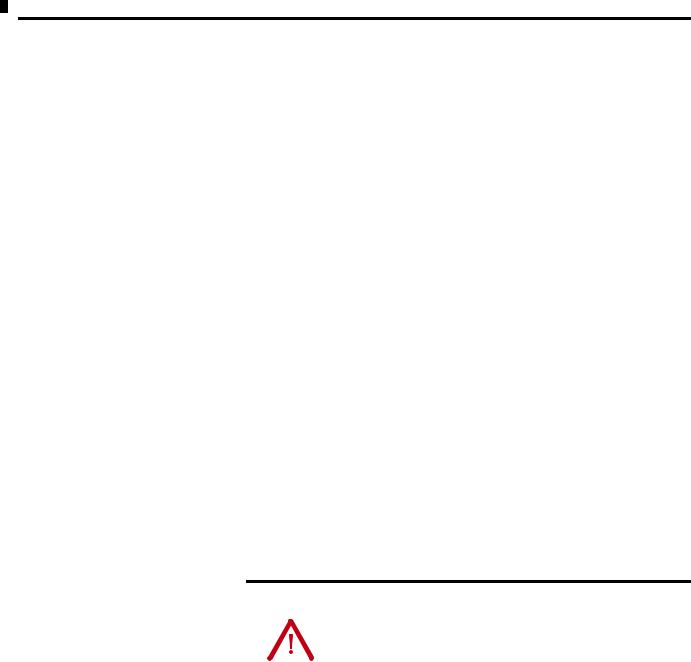
28 How to Install Your Analog Module
Table 2.2
Wiring connections for the 1794-IF2XOF2I Isolated Analog Module when using 1794-TB3, -TB3T, -TB3S, -TB3TS, -TBN and -TBNF Terminal Base Units
Channel |
Signal Type |
Label Markings |
|
1794-TB3, -TB3T(2), -TB3S, |
|
|
|
|
|
-TB3TS(2) -TBN, -TBNF |
|
|
|
|
|
Signal |
Signal Return |
|
|
|
|
Terminal |
|
|
|
|
|
|
|
Output 0 |
Current |
I2 |
|
8 |
|
|
|
|
|
|
|
|
Current |
I2 Ret |
|
|
9 |
|
|
|
|
|
|
|
Voltage |
V2 |
|
10 |
|
|
|
|
|
|
|
|
Voltage |
V2 Ret |
|
|
11 |
|
|
|
|
|
|
Output 1 |
Current |
I3 |
|
12 |
|
|
|
|
|
|
|
|
Current |
I3 Ret |
|
|
13 |
|
|
|
|
|
|
|
Voltage |
V3 |
|
14 |
|
|
|
|
|
|
|
|
Voltage |
V3 Ret |
|
|
15 |
|
|
|
|
|
|
|
|
|
|
|
|
|
24V dc Common |
1794-TB3 – 16 thru 33(1) |
|||
|
|
1794-TB3T, -TB3TS – 17, 18, 33 |
|||
|
|
1794-TBN, -TBNF – 16 and 33 |
|||
|
|
|
|
||
|
+24V dc power |
|
1794-TB3 – 34 thru 51 |
||
|
|
1794-TB3T, -TB3TS – 34, 35, 50, 51 |
|||
|
|
1794-TBN, -TBNF – 34 and 51 |
|||
|
|
|
|
|
|
|
|
|
|
|
|
(1)Terminals 16 thru 33 are internally connected in the terminal base unit.
(2)Terminal 39 through 46 are chassis ground. Terminals 36, 37, 38 and 47, 48, 49 are used or cold junction compensation.
ATTENTION |
Total current draw through the terminal base unit is |
|||
limited to 10A. Separate power connections to the |
||||
|
|
|
||
|
|
|
||
|
|
|
terminal base unit may be necessary. |
|
|
|
|
|
|
|
|
|
|
|
|
|
|
|
|
Publication 1794-6.5.8 - January 2010
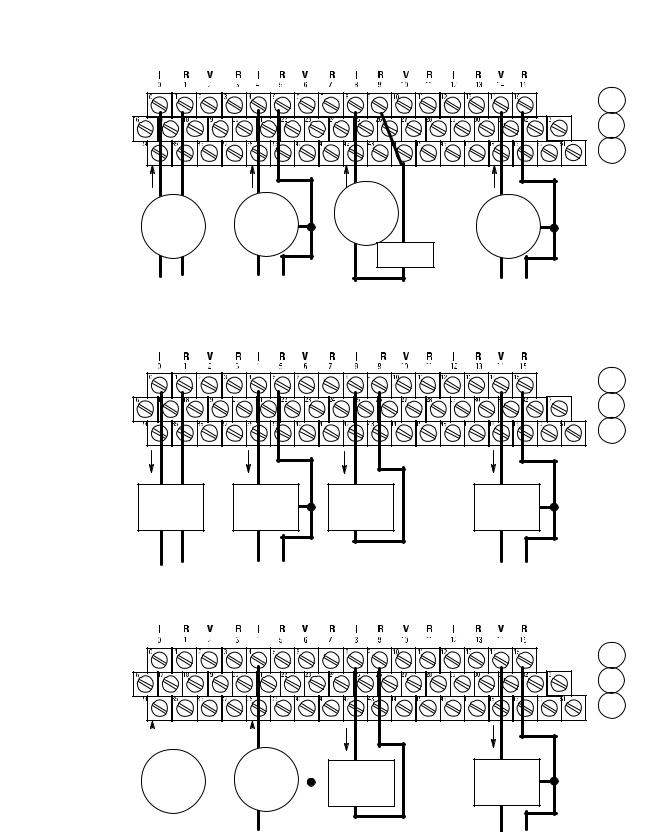
|
|
How to Install Your Analog Module |
29 |
|
|
|
|
Figure 2.6
1794-IF4I Connections ± 1794-TB3 terminal base shown
I |
|
I |
+ |
|
I |
± |
± |
|
|
||||
+ |
|
|
|
Current |
||
Current |
|
Current |
± |
|||
|
|
Input |
||||
Input |
|
|
Input |
|
+ |
± |
+ |
± |
+ |
|
|
24V dc |
|
|
|
|
Power Supply |
|||
|
|
|
|
|
|
+ |
ac or dc |
dc only |
Current only |
|
4-Wire Current |
3-Wire Current |
||
2-Wire Current |
|||
Transmitter |
Transmitter |
Transmitter and External |
|
|
|
Power Supply |
1794-OF4I Connections ± 1794-TB3 terminal base shown
I |
|
+ |
± |
Current
Output
Device
+ ±
ac or dc 4-Wire Output
Device
I |
+ |
Current ±
Output
Device
+
dc only 3-Wire Output Device
I |
+ |
Current
Output
Device
±
Current only 2-Wire Output
Device
1794-IF2XOF2I Connections ± 1794-TB3 terminal base shown
I |
|
|
|
± |
I |
|
|
|
+ |
|
|
|
|
|
|
|
|
|
|
|
|
|
|||||
|
|
|
|
|
|
|
|
|
|
||||
|
|
|
|
|
|
|
|||||||
+ |
|
|
|
|
|
|
|
|
|
|
|||
|
|
|
Current |
|
|
|
|
Current |
± |
||||
+ |
Input |
± |
+ |
|
|
Input |
|
|
|||||
|
|
|
|
|
|
|
|
|
|||||
|
|
|
|
|
|
|
|||||||
|
|
|
|
|
|
|
|
|
|
|
|
|
|
|
|
|
ac or dc |
|
|
|
|
dc only |
|
||||
|
4-Wire Current |
3-Wire Current |
|||||||||||
|
|
|
Transmitter |
|
|
Transmitter |
|||||||
I |
+ |
Current
Output
Device
±
Current only
2-Wire Output
Device
A |
0 ±15 |
|
|
B |
16±33 |
C |
34±51 |
I +
Voltage ±
Input
+
dc only 3-Wire Transmitter
|
A |
0 ±15 |
|
|
|
|
B |
16±33 |
|
C |
34±51 |
I |
|
|
+ |
|
|
Voltage |
± |
|
Output |
|
|
|
|
|
Device |
|
|
+ |
|
|
dc only |
|
|
3-Wire Output |
|
|
Device |
|
|
|
A |
0 ±15 |
|
|
|
|
B |
16±33 |
|
C |
34±51 |
I |
|
|
+ |
|
|
Voltage |
± |
|
Output |
|
|
Device |
|
|
+ |
|
|
dc only |
|
|
3-Wire Output |
|
|
Device |
|
|
Publication 1794-6.5.8 - January 2010
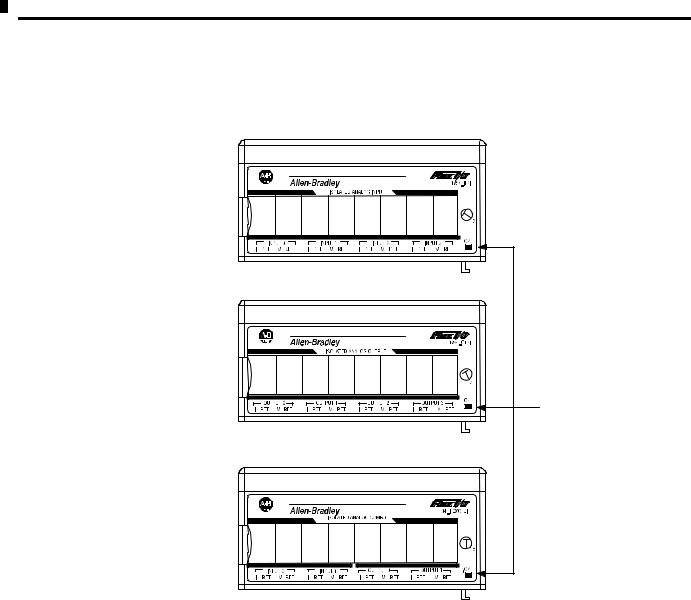
30 How to Install Your Analog Module
Module Indicators
The analog modules have one status indicator that is on when power is applied to the module.
1794-IF4I
1794-OF4I
1794-IF2XOF2I
OK Status Indicator ± Indicates power applied to module and status. When flashing, examine module status word.
Chapter Summary
In this chapter you learned how to install your input module in an existing programmable controller system and how to wire to the terminal base units.
Publication 1794-6.5.8 - January 2010
